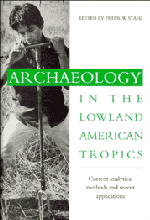Book contents
- Frontmatter
- Contents
- List of figures
- List of tables
- List of contributors
- Introduction
- 1 Archaeological survey and site discovery in the forested neotropics
- 2 The archaeology of community organization in the tropical lowlands: a case study from Puerto Rico
- 3 Archaeological methods for the study of ancient landscapes of the Llanos de Mojos in the Bolivian Amazon
- 4 Searching for environmental stress: climatic and anthropogenic influences on the landscape of Colombia
- 5 “Doing” paleoethnobotany in the tropical lowlands: adaptation and innovation in methodology
- 6 Plant microfossils and their application in the New World tropics
- 7 Differential preservation histories affecting the mammalian zooarchaeological record from the forested neotropical lowlands
- 8 Biological research with archaeologically recovered human remains from Ecuador: methodological issues
- 9 Interpreting dietary maize from bone stable isotopes in the American tropics: the state of the art
- 10 From potsherds to pots: a first step in constructing cultural context from tropical forest archaeology
- 11 Returning to Pueblo Viejo: history and archaeology of the Chachi (Ecuador)
- References
- Index
11 - Returning to Pueblo Viejo: history and archaeology of the Chachi (Ecuador)
Published online by Cambridge University Press: 23 November 2009
- Frontmatter
- Contents
- List of figures
- List of tables
- List of contributors
- Introduction
- 1 Archaeological survey and site discovery in the forested neotropics
- 2 The archaeology of community organization in the tropical lowlands: a case study from Puerto Rico
- 3 Archaeological methods for the study of ancient landscapes of the Llanos de Mojos in the Bolivian Amazon
- 4 Searching for environmental stress: climatic and anthropogenic influences on the landscape of Colombia
- 5 “Doing” paleoethnobotany in the tropical lowlands: adaptation and innovation in methodology
- 6 Plant microfossils and their application in the New World tropics
- 7 Differential preservation histories affecting the mammalian zooarchaeological record from the forested neotropical lowlands
- 8 Biological research with archaeologically recovered human remains from Ecuador: methodological issues
- 9 Interpreting dietary maize from bone stable isotopes in the American tropics: the state of the art
- 10 From potsherds to pots: a first step in constructing cultural context from tropical forest archaeology
- 11 Returning to Pueblo Viejo: history and archaeology of the Chachi (Ecuador)
- References
- Index
Summary
Prologue
An earlier version of this paper was presented to the 1987 Bennington Conference on Lowland South America, an event that Ken Kensinger has been hosting for a number of years. Don Lathrap was not attending the conference, so I sent him a copy of the paper. A few weeks later, Don mailed the manuscript back, his only comment scrawled across the title page: “I hope you get to Pueblo Viejo, for I have been there.” I never found out what Don meant by this comment. As far as I know, he was never physically present in the Santiago-Cayapas region of northern Esmeraldas Province (Ecuador), much less at Pueblo Viejo, the legendary home of the Chachi. Perhaps Don's message was just one of those simultaneously reprimanding and encouraging prods. Or perhaps Don was speaking in a shamanic voice: “I have taken flight-medicine to Pueblo Viejo.” Maybe it was just some lingering fight with Berkeley where, contra Roosevelt (1989: 58), I completed my graduate training. Who knows?
Anyway, Don, I'm still trying to get to Pueblo Viejo. The following paper falls under the rubric of “ethnohistory,” one of those hybrid terms in which anthropology asserts a cross-disciplinary status. A main issue is the origin of the 3,000 or so Chachi who currently occupy the tropical forest lowlands centering on the Cayapas Basin of the Esmeraldas coast.
- Type
- Chapter
- Information
- Archaeology in the Lowland American TropicsCurrent Analytical Methods and Applications, pp. 243 - 262Publisher: Cambridge University PressPrint publication year: 1995
- 3
- Cited by



